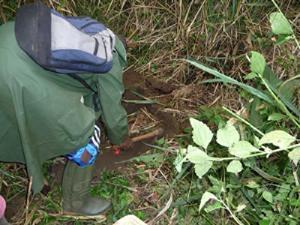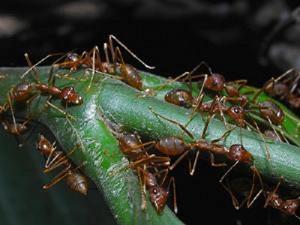Kolo Yeo
This project aims at providing scientific information about the state of biodiversity conservation in Banco National Park, focussing on ants.

Team member digging soil to isolate a monolith.
Banco National Park is 3000ha of primary forest situated inside Abidjan city. It is one of the rare urban National Parks in West Africa. This forest offers many ecosystem services to the city inhabitants (air purification, climate regulation, entertainment opportunities). It also constitutes a refuge for the Guineo-Congolean forest biodiversity. Despite its importance, the park is victim of several aggressions (abusive logging of rare species, poaching, searching for firewood and medicinal plants, pollution, and uncontrolled human settlements threatening its limits). These threats are due to people living around the park and also to neighbouring industrial units. This situation was worsened by massive arrival at Abidjan of people coming from the inner country during the recent militaro-political crisis. These human pressures give rise to a fundamental question as what is the current conservation state of the park.

Ants.
My project intends to assess impacts of these pressures on biodiversity, focusing on ant communities that are known to reflect their habitat’s health. Ants play important roles in terrestrial food webs, functioning as predators, herbivores, mutualists and preys. They are essential for the dispersion of several plants and are considered to be ecological engineers because they can influence nutrients availability for other organisms.
I’ll use standard methods for collecting ants, and investigate species richness, diversity and community structure along an anthropogenic gradient. I’ll define two zones according to this gradient: a zone under human influence and an intact zone.
I’ll address ants from 3 strata:
Leaf litter ants will be collected using Ants of Leaf Litter protocol which combines Winkler bags’ use for extracting ants from sifted litter and pitfall traps for capturing foraging ants. This protocol uses 200m transect, along which 20 litter samples and 20 pitfalls are collected at 10m interval.
Ground ants will be collected using monoliths method along a 200m transect. 20 soil monoliths (30cmx30cmx15cm) will be dug out at 10m interval and ants sorted by hand in the field.
Arboreal ants will be collected using tuna baits placed at 1.5m high on 20 tree trunks 10m apart along a 200m transect.
I’ll Chose 3 replicates sampling sites in each zone.
I hope to provide understandable scientific information about the threats on the park. Such information may help persuade the authorities about the need to reinforce the park’s protection. I also aim at promoting ants as a tool in conservation biology in Côte d’Ivoire.